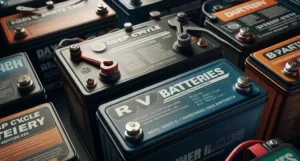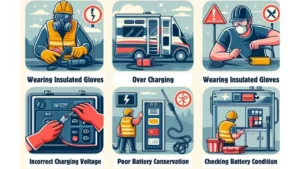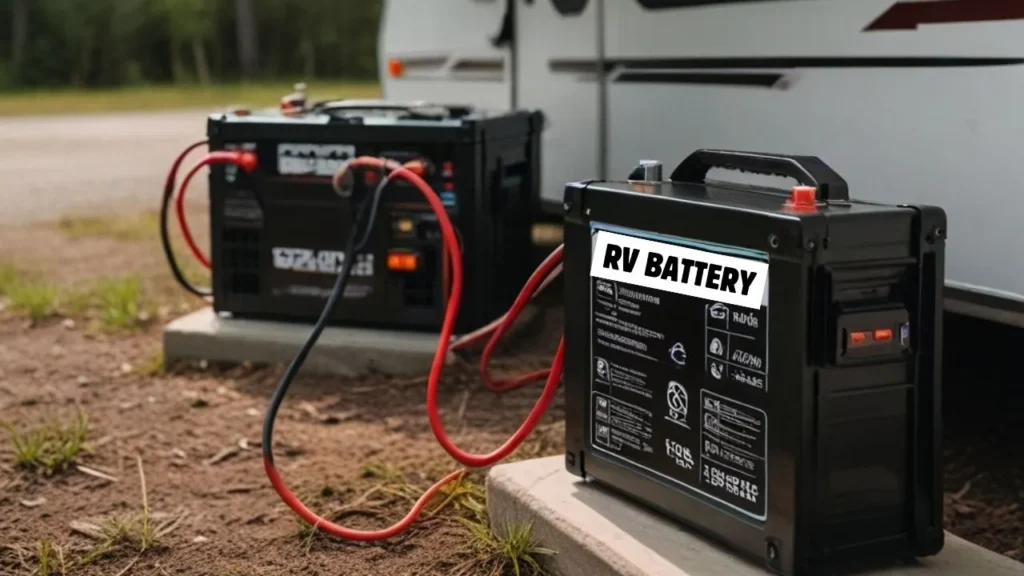
Charging your RV battery is a pivotal aspect of RV power, ensuring you have dependable authority for all your adventures on the road. Whether you are a seasoned RVer or new to the life, gathering How to charge an RV battery duly is essential. In this companion, we’ll explore the colorful styles and tips for charging your RV battery effectively, keeping you powered up wherever your peregrination take you.
Understanding RV Battery Basics
RV batteries are essential factors of your recreational agent, furnishing authority for colorful onboard systems, involving radiance, jiggers, electronics, and more. Gathering the basics of RV batteries is pivotal for maintaining authority during your peregrination and ensuring a smooth and pleasurable camping experience. Then is a complete companion to support you understand RV batteries
Types of RV Batteries:

Deep Cycle Batteries
- Deep cycle batteries are designed to give a steady and harmonious force of power over extended ages.
- They’re specifically finagled to repel repeated discharge and recharge cycles without sustaining damage.
- Deep cycle batteries are ideal for powering caravan house systems, similar as lights, water pumps, and appliances.
- They come in colorful types, including swamped lead-acid, gel, and AGM (Absorbent Glass Mat), each offering different characteristics and performance benefits.
Starting Batteries
- Starting batteries, also known as lattice batteries, are designed to give a high burst of power to start the RV machine.
- Unlike deep cycle batteries, starting batteries aren’t intended for deep discharge cycles and may sustain damage if used for house power operations.
- Starting batteries are generally used in confluence with deep cycle batteries in RVs to power different systems independently.
Binary-Purpose Batteries
- Binary-purpose batteries are cold-blooded designs that combine rudiments of deep cycle and starting batteries.
- They offer a balance between furnishing sufficient starting power for the engine and delivering acceptable house power for onboard systems.
- While protean, binary-purpose batteries may not offer the same position of performance or life as devoted deep cycle batteries for house power operations.
RV Battery Voltage
RV batteries are available in different voltage conditions, with the most common options being 12- volt and 6- volt configurations
12- Volt Batteries
- 12- volt batteries are the most extensively used power source in RVs, offering a balance between capacity and size.
- They’re generally installed collectively or in resemblance configurations to meet the power demands of onboard systems.
- Most RVs come equipped with one or further 12- volt deep cycle batteries for house power operations.
6- Volt Batteries
- 6- volt batteries are frequently used in dyads, connected in series to produce a 12- volt power force.
- When connected in series, two 6- volt batteries effectively double the capacity and amp-hour standing compared to a single 12- volt battery.
- While less common than 12- volt batteries, 6- volt batteries are preferred by some RV possessors seeking advanced capacity and longer battery life.
How do I choose the right charger for my RV batteries?
Here’s are some factors to consider when opting a bowl for your RV batteries
Charging Capacity
- Consider the charging capacity of the bowl, which is generally measured in amps (amperes). The charging capacity should be sufficient to meet the requirements of your RV battery bank. Calculate the total amp-hour (Ah) capacity of your battery bank and choose a bowl with a matching or slightly advanced charging capacity.
Charging system
- Decide on the charging system that stylish suits your requirements and preferences. Common charging styles include single-stage, multi-stage, and smart charging. Single-stage chargers give a constant charging voltage, while multi-stage chargers offer different charging biographies for bulk, immersion, and float charging. Smart chargers are equipped with advanced charging algorithms that optimize charging effectiveness and battery health.
Portability and Installation
- Consider the portability and ease of installation of the bowl, especially if you plan to use it in different locales or while traveling. Choose a bowl that’s featherlight, compact, and easy to install in your RV. Some chargers come with mounting classes or handles for accessible installation and transportation.
Safety Features
- Look for chargers with erected-in safety features to cover your batteries from overcharging, short circuits, and rear opposition. Important safety features to consider include overcharge protection, load protection, thermal protection, and spark-evidence design. Choose a bowl from an estimable manufacturer that meets safety norms and instruments.
Compatibility with Charging Systems
- Ensure that the bowl is compatible with your RV’s charging system, including any being solar panels, creators, or reinforcement power connections. Some chargers are designed to work seamlessly with external power sources and can automatically switch between different charging inputs for optimal performance.
Budget and Warranty
- Consider your budget and the long-term value of the charger, including bond content and client support. Compare prices and features of different dishes to find the stylish option that offers the right balance of performance, trustability, and affordability. Look for dishes with a bond period that provides acceptable protection and peace of mind.
By considering these factors, you can choose the right bowl for your RV batteries that meets your specific requirements and conditions. Take the time to probe and estimate different options to ensure that you make an informed decision and invest in a bowl that will give dependable and effective charging for your RV batteries.
How to charge an RV battery?

Charging an RV battery is essential for maintaining power during camping passages and ensuring that your recreational vehicle’s electrical systems serve duly. Then is a step-by-step companion on how to charge an RV battery using different styles
1. Shore Power
- Connect your RV battery to a reinforcement power source, similar to a hutment pedestal or household outlet, using an applicable power cord.
- Ensure that the circuit swell on the reinforcement power source is turned off before plugging in your RV.
- Once connected, switch on the circuit swell and corroborate that power is flowing to the caravan’s electrical system.
- An erected-in motor/ charger or inverter/ charger in your battery will automatically convert the incoming AC power from reinforcement power into DC power to charge the RV batteries.
- Cover the charging process using the caravan’s battery examiner panel or regulator.
2. Generator
- You can use a portable generator to charge your RV batteries, If reinforcement power is unapproachable.
- Start the creator and allow it to run until it reaches operating speed.
- Connect the generator to your RV using a generator cord or appendage.
- Once connected, the generator will give AC power to the generator‘s electrical system, including the battery charger.
- Cover the charging process and ensure that the generator has enough energy to continue running until the batteries are completely charged.
3. Solar Power
- They can charge the batteries using sun, If your RV battery is equipped with solar panels.
- Situate your RV in a position where the solar panels admit direct sun.
- Solar charge regulators regulate the charging process and help to fleece of the batteries.
- Cover the solar charge regulator to ensure that the batteries are entering an acceptable charge from the solar panels.
- Keep in mind that solar charging may take longer than reinforcement power or generator charging, especially on cloudy days or in shadowed areas.
4. Alternator Charging (While Driving)
- When driving your RV, the engine alternator charges the batteries by generating electricity.
- Ensure that the RV’s machine is running, and the alternator is performing rightly.
- The alternator charges the batteries while driving, furnishing power to the RV’s electrical system and charging the batteries contemporaneously.
- Cover the battery voltage and charge position using a battery examiner panel or regulator to ensure that the batteries are charging effectively.
5. Battery Charger (External)
- You can use it to charge your RV batteries, If you have access to an external battery charger.
- Connect the RV battery charger to a power outlet and corroborate that it’s turned off before connecting it to the RV batteries.
- Connect the positive (+) outstation of the bowl to the positive outstation of the battery and the negative (-) terminal to the negative terminal.
- Turn on the battery charger and select the applicable charging mode grounded on the battery type and condition.
- Cover the charging process and dissociate the bowl once the batteries are completely charged to help to fleece.
By following these ways, you can effectively charge your RV battery using different styles depending on your camping position and available coffers. Regularly covering the battery voltage and charge position will help ensure that your caravan’s electrical systems operate easily during your peregrination.
Mistakes to avoid while charging RV batteries:
Overcharging
- Overcharging occurs when batteries admit further charging current than they can safely handle.
- This can lead to inordinate heat buildup, electrolyte loss, and internal damage to the battery cells.
- Avoid leaving the batteries connected to a charger for extended ages without covering their charge position.
- Use a smart charger or charge regulator with erected-in overcharge protection to help to fleece.
Undercharging:
- Undercharging happens when batteries aren’t completely charged before use, leading to salvation and reduced battery capacity over time.
- Ensure that the batteries are charged to their full capacity regularly, especially after ages of desuetude or storehouse.
- Use a dependable charger or charging system that can completely charge the batteries without discounting.
Incorrect Charging Voltage
- Different types of batteries bear specific charging voltages to maintain optimal performance and life.
- Exercise a bowl or charging system that is compatible with the type of batteries instated in your RV (e.g., lead-acid, AGM, gel).
- Relate to the battery manufacturer’s specifications for the recommended charging voltage range and acclimate the bowl settings consequently.
Poor Battery conservation
- Neglecting proper battery conservation can lead to unseasonable battery failure and reduced lifetime.
- Regularly check the batteries for signs of corrosion, electrolyte situations, and physical damage.
- Clean the battery outstations and connections to insure good electrical contact and help voltage drop.
Using the Wrong Charging system
- Using an incompatible or wrong charging system can damage the batteries and pose safety pitfalls.
- Choose a charging system that’s suitable for your RV’s battery setup and camping conditions.
- Avoid using limited dishes, new charging setups, or charging styles not recommended by the battery manufacturer.
Ignoring Temperature Considerations
- Extreme temperatures, both hot and cold, can affect battery performance and charging effectiveness.
- Avoid charging batteries in exorbitantly hot or cold surroundings, as high temperatures can accelerate battery declination, while cold temperatures can reduce charging efficiency.
- However, charge the batteries in a climate-controlled terrain or use temperature- compensated charging styles, If possible.
Disregarding Safety Preventives
- Charging batteries involves working with electrical systems and potentially dangerous voltages.
- Always follow proper safety preventives when charging RV batteries, similar as wearing insulated gloves and eye protection, ensuring proper ventilation in charging areas, and decoupling the charger from the power source before connecting or decoupling the batteries.
RV Battery Charging Safety Tips:

Charging RV batteries is a routine task for numerous RV possessors, but it’s essential to prioritize safety to help accidents and insure optimal battery performance. Then are some RV battery charging safety tips to keep in mind
Read the Owner’s Manual:
- Before charging your RV batteries, familiarize yourself with the manufacturer’s guidelines and recommendations outlined in the proprietor’s primer.
- This will help you understand the specific conditions and preventives for charging your RV batteries safely.
Use the Right Charger
- Invest in a quality battery charger or charging system that’s designed for RV batteries.
- Ensure that the charger is compatible with the type and voltage of your RV batteries to help to fleece or damage.
Check the Batteries
- Before charging, visually check the RV batteries for any signs of damage, corrosion, or leaks.
- However, similar to bulging, cracks, If you notice any abnormalities.
Choose a Suitable Position
- Charge your RV batteries in a well-voiced area with acceptable tailwind to dissipate heat and help the buildup of hydrogen gas, which is emitted during charging.
- Avoid charging batteries in confined spaces or near ignitable accoutrements.
Protective Gear
- Wear applicable particular defensive outfit, similar as gloves and safety goggles, when handling batteries and connecting charging outfit.
- This will help cover you from chemical exposure and help injury in case of accidental tumbles or splashes.
Follow Correct Opposition
- Ensure that you connect the charger cables to the battery outstations following the correct opposition (positive to positive, negative to negative).
- Reversing the opposition can damage the batteries and pose safety pitfalls.
Disconnect Power Source
- Before connecting or decoupling the charger cables, ensure that the charger is unplugged or turned off to help electrical shock or short circuits.
- Always handle charging outfit with dry hands and avoid touching exposed cables or outstations.
Examiner Charging Progress
- Regularly check the charging progress and cover the battery voltage to ensure that the batteries are charging rightly and within the recommended voltage range.
- Avoid leaving batteries unattended while charging, and be prepared to intermediate in case of any issues.
Avoid Overcharging
- Prevent overcharging by using a smart charger or charge regulator with erected-in overcharge protection.
- These devices automatically acclimate the charging voltage and help the batteries from entering further charge than they can handle.
Keep Children and faves Down
- Create a safety border around the charging area and keep children and faves down to help accidental contact with charging outfit or batteries.
- Educate family members about the troubles of handling batteries and charging outfit.
Conclusion:
Charging your RV battery is an abecedarian aspect of RV power, and understanding the colorful styles and tips for effective charging is essential for a flawless trip experience. By following the guidelines outlined in this comprehensive companion, you can ensure your RV battery remains charged and ready for your coming adventure on the open road.







